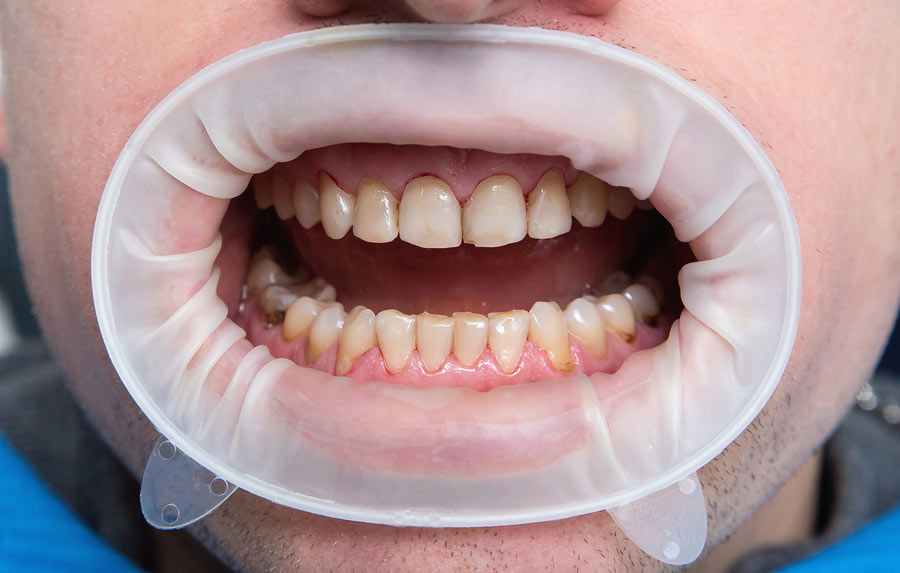Expander Teeth FAQs and General Info

Some of the more common issues, like crowding, crossbites, and overbites, are due to underdeveloped jaws or a major size difference between the top and bottom jaw. Treating these conditions is usually done with a two-step process: first, the underdeveloped or smaller jaw is expanded and then braces are installed to straighten all of the teeth up.
There are several different forms of expander appliances for permanent teeth, such as a palatal expander, posterior crossbite, or rapid palatal expander but they all work in a similar way. The expander is a metal device that fits over several of the back teeth with expansion screws in the middle that widen the device, and thus the palate or jaw when activated. When used on the upper jaw the expander is actually widening the palate. The palate is made of two separate bones that do not fuse together in the middle until around mid-teen years. Therefore, the bones can be gradually pushed apart and set in the wider position before they fuse. A lower jaw expander can only push the teeth out since the lower jaw is a single bone, but this is sometimes necessary if the teeth are angled inward or upright and crowded.
After the expander has been installed, every night they will be activated by turning the expansion screw with a small key. When the jaw or palate has been expanded to the desired point the appliance will continue to be worn for a few months to keep everything in place and allow for the bone, gums, and teeth to set in that position. Eventually, the expander will be removed and braces will likely be installed to reposition the teeth. For more on the basics of the expander and a nice illustrated graphic, visit this page.
Q: Does the installation hurt?
The installation should not be overly painful on permanent teeth. The appliance is attached with sleeve-like metal sheaths that go over several of the back teeth and are cemented in. If there was not much space between the molars, to begin with, then there may be some aching discomfort as the teeth shift to accommodate the appliance.
Q: Does the activating the expander hurt?
The appliance will only be expanded a small amount at a time. Since the bones have not yet fused together the wearer should not experience any pain but will likely feel some pressure. This pressure can last for anywhere from a few minutes to a few hours depending on how mobile their jaw or palate is. The activation is done at night so that the discomfort can be slept through. It should not impact the wearer’s ability to eat.
Q: Does this limit the types of food that can be eaten?
Your orthodontist will advise about foods that must strictly be avoided when wearing the expander, but typically they are limited to sticky and gooey things, like caramels and gum. Aside from the types of food that would stick to the appliance or gum up the expander screws, the limitations are really set by what the wearer can comfortably eat. If soreness persists into the day, then they might want to chew as little as possible. If they feel fine then normal foods like pizza and chips are usually okay.
Q: How long will it need to be worn?
The active expansion phase usually lasts for a few weeks. Afterward, there is a retaining phase where the expander is left in but not actually adjusted. This tends to be for three to six months but can be longer depending on the treatment plan. The actual time depends on the patient and the degree to which things need to be moved around but most people have expanders in for less than a year.
Q: Why does it have to be cemented in?
The purpose of the expander is to make a big change quickly and ensure that the mouth sets in the correct position once the desired size has been met. If the expander were removable the jaw or palate would try to go back to its original position as soon as the device is removed, especially during the early expansion phase. The temptation for a child to take the appliance out when things get uncomfortable could be great, so it is best to ensure that it stays in and gets the job done as quickly as possible. Not doing so would likely lead to a longer treatment time and more trauma to the mouth.
Q: How do you keep it clean?
Regular brushing and flossing should go a long way toward maintaining both regular oral health and the cleanliness of the device. You should be sure to brush the expander section of the appliance while brushing the teeth. It may also be beneficial to get a water flosser to wash out any debris that might get caught up in the appliance.
Q: What happens if I lose the key?
The dentist can easily supply you with a replacement key but if you have forgotten it or cannot get to the office for a few days then a paperclip can usually perform the same function in a pinch. Simply unbend it and shape it to be at the proper angle for making the adjustment.
Q: What if I forget to expand it for a day or two?
While not ideal, it is okay if a day or two is missed. Simply resume the expansion schedule that night. Do not try to overturn the expander to make up for missed days as this can cause excess pain. During the expansion phase, the dentist will be actively monitoring the progress and will simply advise a longer expansion period if the jaw or palate has not reached the desired result in the expected amount of time.
“It is always ideal to have orthodontic appliances demented in, for a couple of reasons. First it takes care of the issue of patient compliance. Since most patients undergoing orthodontic treatment are young, compliance may be an issue for them. In other words, if it were not cemented in, it would be easy for a young patient to take the appliance out without regard to the consequences. Second, having the device permanently in place ensures its stability and allows it deliver accurate results over the course of treatment. “


